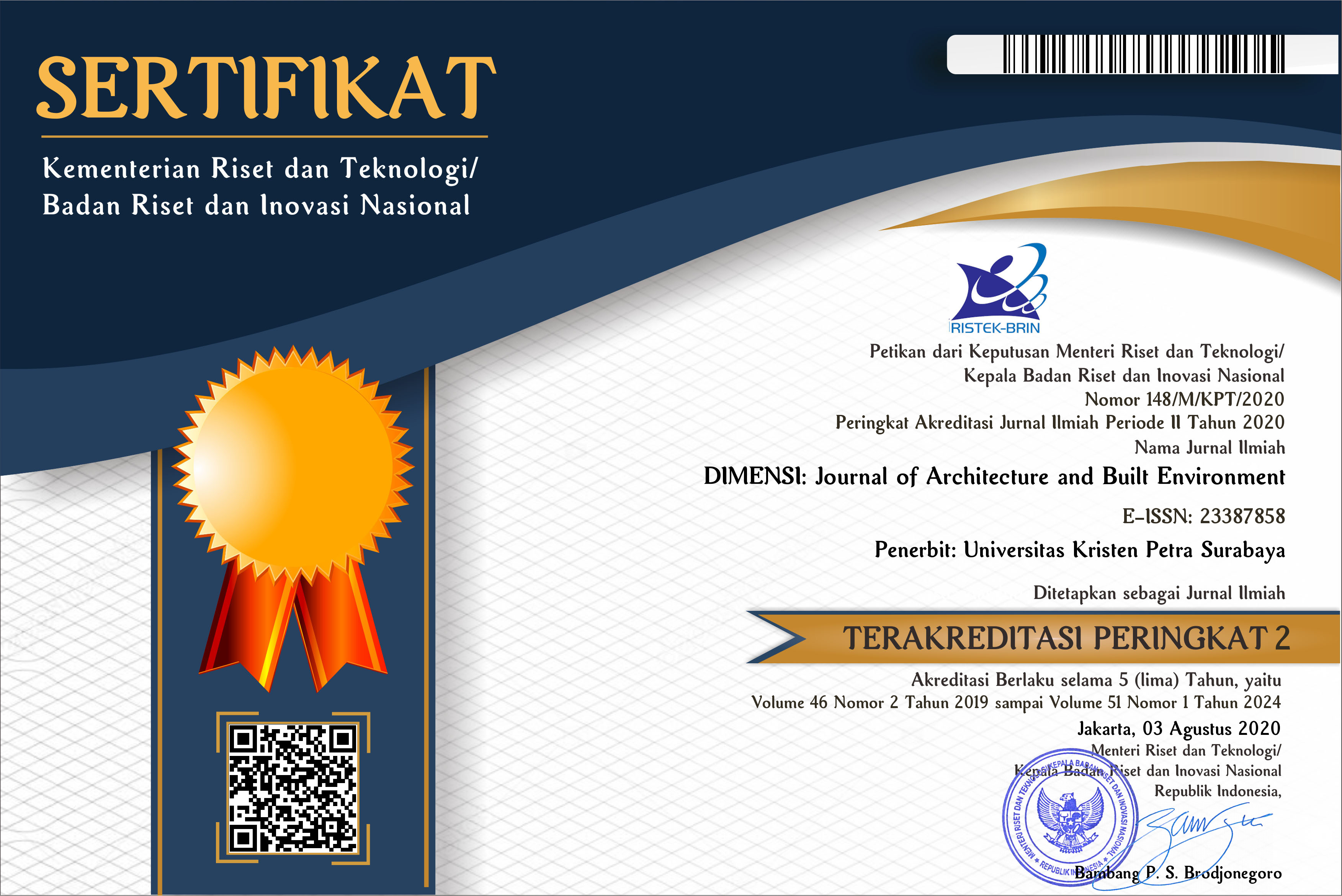DESAIN JENDELA BANGUNAN DOMESTIK UNTUK MENCAPAI "COOLING VENTILATION" Kasus uji: rumah sederhana luas 45m2 di Yogyakarta
 :
:
https://doi.org/10.9744/dimensi.30.1.%25p
Keywords:
ventilation rates, air change per hour, window design, manual test, computational test.Abstract
A two dimensional computational program was used to explore type, dimension, and number of windows in a 45 sqm domestic building to achieve cooling ventilation rates in 0 m/s outdoor windspeed. Prior to this, a manual calculation was constructed to limit and predict how the input for computational test would be. As in the manual test, the type of windows to be tested is jalousie (louvre) and casement. Primary and secondary weather data was also prepared for input. Subject to change variable is dimension and number of windows. Both manual and computational test indicated that to provide cooling ventilation rates (30 ach) in 0 m/s outdoor windspeed, the domestic building requires window area of approximately 50% floor area. Abstract in Bahasa Indonesia : Desain jendela bangunan domestik untuk mencapai "cooling ventilation" (30 air change per hour (ach) yang sangat dianjurkan bagi bangunan di daerah tropis lembab diuji pada studi ini. Pengujian dilakukan dengan sistem komputasi dua dimensi dan difokuskan pada kondisi kecepatan angin di seputar bangunan = 0m/det. Untuk memperkirakan model, dimensi dan jumlah jendela, sebelumnya telah dilakukan uji manual pada beberapa bangunan sejenis. Hasil uji manual yang telah dilengkapi dengan data-data primer dan sekunder mengenai suhu, kecepatan dan arah angin kemudian disusun sebagai input uji komputasi. Variabel yang senantiasa dirubah pada proses uji kali ini adalah dimensi dan jumlah jendela. Uji komputasi ini juga bertujuan untuk mem-validasi hasil uji manual tersebut. Kesimpulan yang dihasilkan tidak terlalu jauh berbeda dari kesimpulan pada uji manual, yaitu bahwa untuk memperoleh tingkat ventilasi cooling (30 ach) diperlukan luas jendela sekitar 50% luas lantai.Downloads
Download data is not yet available.
Published
2004-06-17
How to Cite
E. Mediastika, C. (2004). DESAIN JENDELA BANGUNAN DOMESTIK UNTUK MENCAPAI "COOLING VENTILATION" Kasus uji: rumah sederhana luas 45m2 di Yogyakarta. DIMENSI (Journal of Architecture and Built Environment), 30(1). https://doi.org/10.9744/dimensi.30.1.%p
Issue
Section
Articles
License
Authors who publish with this journal agree to the following terms:
- Authors retain copyright and grant the journal right of first publication with the work simultaneously licensed under a Creative Commons Attribution License that allows others to share the work with an acknowledgement of the work's authorship and initial publication in this journal.
- Authors are able to enter into separate, additional contractual arrangements for the non-exclusive distribution of the journal's published version of the work (e.g., post it to an institutional repository or publish it in a book), with an acknowledgement of its initial publication in this journal.
- Authors are permitted and encouraged to post their work online (e.g., in institutional repositories or on their website) prior to and during the submission process, as it can lead to productive exchanges, as well as earlier and greater citation of published work (See The Effect of Open Access).

















